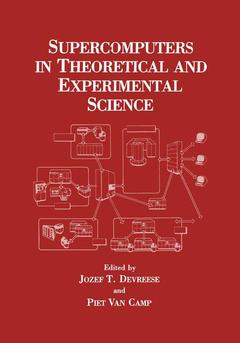Supercomputers in Theoretical and Experimental Science, Softcover reprint of the original 1st ed. 1985
Langue : Anglais
Auteurs : Devreese Jozef T., Camp Piet Van

The International Workshop on "The Use of Super computers in Theoretical Science" took place from July 30 till August 1, 1984, at the Conference Center of the "Priorij Corsendonk", close to the city of Antwerpen, Belgium. During the past decade computational science has developed itself to a third methodology besides the experimental and theoretical sciences. This remarkable evolution was only possible due to a drastic increase of the computational power of present day computers. Indeed, computational physics and chemistry as such is certainly not new, but it was only during the past ten years or so that realistic problems could be solved numerically to a sufficient degree of accuracy. During this workshop the state-of-the-art in high speed computation was presented by a team of lecturers who are well known for their competence in this field. It is a pleasure to thank several organizations and companies who made this workshop possible. First of all, the main sponsors: the Belgian National Science Found ation (NFWO-FNRS) and the "Universitaire Instelling Ant werpen". Next, the co-sponsors: Agfa-Gevaert N. V., Control Data Belgium and the Belgian Ministry of Education. Special thanks are due to Dr. P.E. Van Camp and Drs. H. Nachtegaele for the practical organization of this workshop. I would also like to thank Mrs. H. Evans for typing the manuscripts and for preparing the author and subject index. v Last but not least I express my gratitude to Mr.
I. Introduction.- Science, Simulation and Supercomputers.- 1. Introduction.- 2. A far-reaching manifesto.- 3. The scientific progress.- 4. A revolution in scale.- 5. Supercomputers, who needs them?.- 6. Some final remarks.- 7. References.- II. SIMD Supercomputers.- Vector Processing on CRAY-1 and CRAY X-MP.- 1. Introduction.- 2. Principles of CRAY-1 architecture.- 3. Architecture of CRAY X-MP.- 4. Chaining.- 5. Execution sequence of Fortran kernels on CRAY-1 and CRAY X-MP.- 6. CFT — the CRAY Fortran compiler.- 7. Optimizing Fortran programs for the CRAY.- 8. Conclusion.- 9. Acknowledgments.- 10. References.- Vector Processing Techniques on CYBER 205.- Abstract.- 1. Introduction.- 1.1. Horizontal parallelism.- 1.2. Vertical parallelism.- 2. Some remarks on CYBER 205 data operators.- 2.1. Scalar method.- 2.2. The single-vector method.- 2.3. The use of control vectors.- 2.4. VXTOV (scatter-gather) technique.- 2.5. The compress method.- 3. Numerical examples.- (a) Iterative Gaussian method of Traub.- (b) Vectorized Jacobi method.- (c) SOR-method.- 4. References.- Programming Discipline on Vector Computers: “Vectors” as a Data Type and Vector Algorithms.- 1. The vector machine.- 1.1. A look at CRAY-1 performances.- 1.2. Which operations benefit from vector speed, and why?.- 1.2.1. Extensions.- 1.2.2. Arrays of processors and pipe-lines.- 1.2.3. Memory access,regular storage.- 1.3. The ‘vector machine’ concept.- 2. Vector algorithms.- 2.1. Linear recurrence.- 2.1.1. ‘Iterative’ approach: recursive doubling.- 2.1.2. ‘Recursive’ approach: cyclic reduction.- 2.1.3. Discussion.- 2.2. Linear algebra.- 2.3. The ‘total’ reduction problem.- 2.3.1. Statement of the problem.- 2.3.2. Examples of problems of the ‘total reduction’ family.- 2.3.3. Vector methods for problem (52).- 2.3.4. A pipeline for the reduction problem.- 2.4. Sum of the components, and dotproduct, on CRAY-1.- 3. References.- III. MIMD Supercomputers.- MIMD Supercomputers for Numerical Applications.- 1. Vector computers — parallel computers.- 1.1. Architectural type.- 1.2. Programming a supercomputer.- 2. Numerical applications on MIMD parallel supercomputers.- 2.1. Parallel approach to solve numerical problems.- 2.2. Programming aspects on MIMD supercomputers.- 2.3. Program optimization.- 3. Architectures MIMD and performance.- 3.1. Software concepts.- 3.2. Hardware concepts.- 3.3. Loosely coupled MIMD architectures.- 3.4. Task sequencing language.- 3.4.1. Different task types.- 3.4.2. DECLARE and ALLOCATE parts.- 3.4.3. Sequencing expressions.- 3.5. Simulation results.- 3.5.1. Characteristics of the simulator.- 3.5.2. Performances.- 4. Implementing and concepts.- 4.1. Multi-array-processor confiruration.- 4.2. Parellel language implementation.- 4.3. Programming parallel applications.- 4.4. Configuration evolution: performance evaluation.- 5. Conclusion.- 6. Acknowledgments.- 7. References.- IV. Applications.- Supercomputers in Theoretical High-Energy Physics.- Abstract.- 1. Introduction.- 2. Computational physics.- 3. The CYBER 205.- 4. The Monte-Carlo method for lattice gauge theory.- 5. Acknowledgment.- 6. References.- The Use of a Vector Computer in Ab-Initio Phonon Calculations in Semiconductors.- 1. Introduction.- 2. Theory.- 3. Computational procedures.- 3.1. The electron-ion potential.- 3.2. The electronic band structure.- 3.3. The total crystal energy.- 3.4. Vectorization of the codes.- 3.4.1. Matrix multiplication.- 3.4.2. Matrix inversion.- 3.4.3. Matrix diagonalization.- 3.4.4. The polarizability matrix.- 4. Discussion of the results.- 4.1. Convergence as a function of the dimension of e.- 4.2. Convergence as a function of the number of plane waves in the basis.- 4.3. The dispersion curves.- 5. Conclusions.- 6. Acknowledgments.- 7. References.- Numerical Solution of the Time-Dependent Hartree-Fock Equation in the Electron Gas.- 1. Introduction.- 2. The homogeneous electron gas model.- 2.1. Energy loss of X-rays and fast electrons.- 2.2. The effective potential in solids.- 3. The time-dependent Hartree-Fock (TDHF) equation.- 4. Variational solution of the TDHF equation.- 5. Numerical solution of the TDHF equation.- 5.1. Construction of a set of linear equations.- 5.2. Evaluation of $$A_j^{\left[ f \right]}\left( {k,v} \right) = \operatorname{Im} \int_{{S_J}} {{d^2}} \xi \frac{{f(\vec \xi )}}{{{v^ + } - {\Lambda _K} \to (\vec \xi )}}$$.- 5.3. Evaluation of $$A_j^{\left[ f \right]}\left( {k,v} \right) = \operatorname{Re} \int_{{S_J}} {{d^2}} \xi \frac{{f(\vec \xi )}}{{{v^ + } - {\Lambda _K} \to (\vec \xi )}}$$.- 6. Concluding remarks.- 7. References.- An Overview of Computing at Los Alamos.- Abstract.- 1. Introduction.- 2. Application program characteristics.- 3. Future requirements.- 4. An integrated plan.- 4.1. Feeding.- 4.2. Caring for.- 4.3. Cleaning-up.- 5. Summary.- 6. Acknowledgments.- 7. References.- V. Indexes.- Author Index.
Date de parution : 02-2012
Ouvrage de 238 p.
17.8x25.4 cm
Disponible chez l'éditeur (délai d'approvisionnement : 15 jours).
Prix indicatif 52,74 €
Ajouter au panier
© 2024 LAVOISIER S.A.S.
